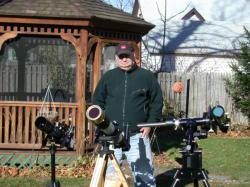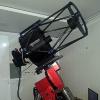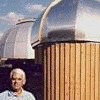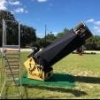I was wondering what, if any, benefit I may get from an H-alpha filter designed for viewing nebula emissions. It's about 7nm wide FWHM. I understand that's really wide by solar viewing standards, will there be any benefit with even say flares or prominences?
Thanks,
Mike
Many people wonder why you can't use a white-light solar filter in conjunction with a night-time Hydrogen alpha nebula filter to see solar flares and prominences. The first thing you must understand is that the sun is composed of many layers, which give off and absorb light in differing ways.
The baseline of light coming from within the sun gives the bright "continuous spectrum" of all the colors of the rainbow. This is known as the "thermal" or "blackbody" radiation, and any dense solid object will produce this radiation (because of the sun's high internal density, it acts like a solid object at normal earthlike temperatures). As the temperature rises, the body will shift from giving off infrared (heat) energy to visible energy and into the ultraviolet and beyond, in the form of a continuous spectrum. Most stars are classified on this basis of where the peak of their light output falls in the visible spectrum.
Because the sun is not a solid body, the relatively cooler gases that lie above the layers producing the continuous spectrum can absorb certain frequencies of light, which correspond the amount of energy required to shift electrons of a given element into a higher energy level, or "orbit." Thus when an electron orbiting the proton of a Hydrogen atom absorbs a discrete amount of energy to shift the electron, it removes the corresponding color, or frequency, of light from the continuous spectrum coming from below, and an "absorption line" is created in the spectrum.
If we look closely at the bright continuous spectrum of the sun, we observe many "spectral lines" corresponding to the various elements of the gases in the photosphere -- the "absorption spectrum." Relatively cool (6000 degrees C) hydrogen gas in the photosphere absorbs light coming up from below, and we see a very dark line – the Hydrogen alpha absorption line -- in the continuous spectrum. It is the darkest line, and relatively wide, because the sun is mostly hydrogen, and it is this gas that predominates the layers of the photosphere.
The sun's chromosphere lies above the photosphere, and is much hotter -- 20,000 degrees C. At these higher temperatures we see what is know as an "emission spectrum". Here light is being given off instead of absorbed, corresponding to the energy given off when the electron shifts back down to a lower energy state, and at the same frequency or "color" of light which is absorbed in the photosphere. Even though it is much hotter than the photosphere, the amount of light coming from the chromosphere -- which is far less dense than the photosphere -- is correspondingly less intense by several orders of magnitude.
In order to see the chromosphere and it's flares, prominences, etc., you must first totally eliminate all the bright light coming from the photosphere, except where the broad H alpha absorption line is. Since the Hydrogen in the photosphere is absorbing the exact wavelength of light we are interested in, all that will be left to see is the relatively weak H alpha emission coming from the chromosphere.
This is why you can't use a white light solar filter with a nebula filter and see chromospheric features like flares and prominences: The white light filter reduces the H alpha emission from the chromosphere by the same amount it reduces all the other wavelengths from the photosphere. The wide bandwidth of a nebula filter only lets you see the photospheric features from light coming from either side of the photospheric absorbtion line, and the chromosphere emission itself is reduced by the white light filter to invisibility.


























